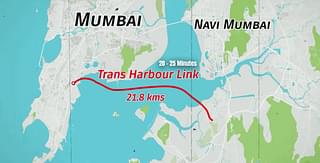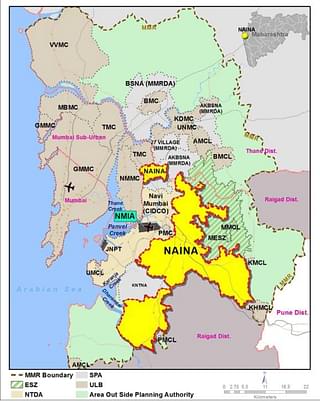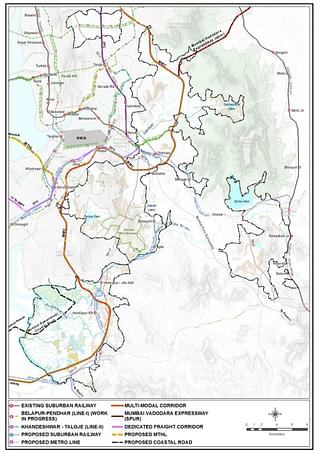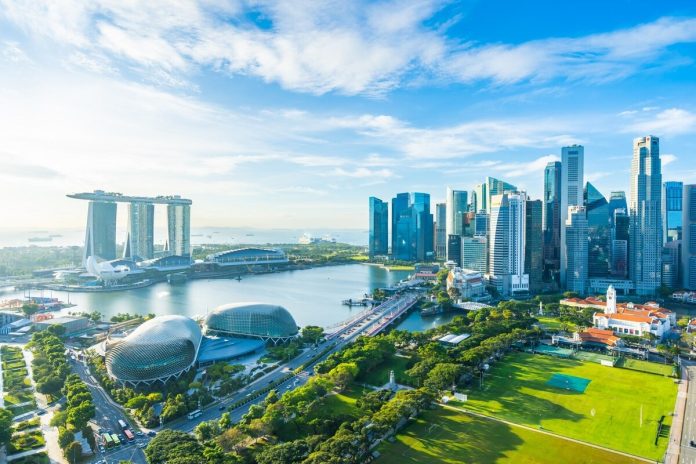In a bold step to address the growing population and economic needs of the Mumbai Metropolitan Region (MMR), the Maharashtra state government recently approved an ambitious proposal for the development of a ‘third Mumbai’ city.
The new city will be built around the Navi Mumbai International Airport, which will be connected to Mumbai via the Mumbai Trans Harbour Link (MTHL).
The MTHL is India’s longest sea bridge — a 22-km-long sea link that will connect Mumbai with its satellite city, Navi Mumbai.
The proposed third Mumbai city aims to address critical issues faced by the MMR, including housing shortages, inadequate infrastructure, and transportation bottlenecks.
The ‘Third Mumbai’
The Mumbai Metropolitan Region Development Authority (MMRDA) is expected to play a pivotal role in reshaping the far reaches of the MMR. To facilitate this change, a dedicated body, the New Town Development Authority (NTDA), has been established.
The new city will be spread across 323 square kilometres, encompassing Ulwe, Pen, Panvel, Uran, Karjat, and the neighbouring areas.
Around 200 villages, including 80-90 villages under the Navi Mumbai Airport Influence Notified Area (NAINA), are also expected to be a part of it.


Why A ‘Third Mumbai’?
The vision for the ‘third Mumbai’ includes a fully developed city with residential complexes, commercial hubs, data centres, offices of multinational corporations, banks, financial institutions, and knowledge parks.
A comprehensive public transportation system is also in the works to stimulate economic activity and contribute significantly to India’s gross domestic product (GDP).
The development plan envisions a second Bandra-Kurla Complex in Kharghar, spanning 150 hectares, serving as a dedicated commercial area to attract both Indian and multinational companies.
The overall vision aligns with the government’s plan to transform the MMR into a region capable of creating a $0.25 trillion economy.
The MTHL and Navi Mumbai International Airport are expected to play a key role in boosting India’s GDP, potentially adding one percentage point, as reported by Hindustan Times.
The new airport, slated to open in December 2024, aims to alleviate pressure on Mumbai’s existing airport and enhance regional connectivity.
The MMRDA and NITI Aayog, the country’s planning agency, are working in collaboration to elevate Mumbai’s GDP from the current $140 billion to $300 billion by 2030. The ‘third Mumbai’ is a vital part of this economic masterplan.
Concerns about affordable housing opportunities have been raised, particularly in areas like NAINA, due to high development charges. Developers emphasise the importance of balancing economic growth with accessible housing to ensure sustainable urban development.
To strengthen public transportation, the Mumbai Rail Vikas Corporation is implementing the Panvel-Karjat suburban rail corridor at a cost of Rs 812 crore.
The project, set to be completed by December 2025, involves three tunnels, two rail flyovers, and five railway stations, connecting Navi Mumbai with the Raigad district of MMR.
This corridor is expected to reduce congestion on suburban local trains and act as a catalyst for the overall development of Panvel, Karjat, NAINA, and the proposed NTDA.
Navi Mumbai (Mumbai 2.0) and NAINA
The City and Industrial Development Corporation (CIDCO) initiated the development of Navi Mumbai in the 1970s, aiming to create a counter-magnet to Mumbai.
The existing airport at Mumbai is fast reaching saturation, and scope for further enhancement appears constrained in terms of passenger and cargo handling facilities, aircraft maintenance, and cityside facilities.
The air travel demand forecast indicated that demand will grow from 30 million passengers per annum in the year 2012-13 to over 100 million passengers by 2030-31. It was, thus, imperative to build a second airport in MMR.
To meet the growing demands of air travel, following the policy of greenfield airports, CIDCO initiated studies for locating the airport within Navi Mumbai and selected a location close to the mouth of Panvel Creek.
Apprehensions about haphazard development around the proposed airport, if sufficient care is not taken, led to the declaration of the area around the proposed airport as NAINA.
NAINA is crucial for the economic base provided by the proposed Navi Mumbai International Airport, Taloja Industrial Area, and Jawaharlal Nehru Port Trust, according to a CIDCO report.


Mistakes The ‘Third Mumbai’ Should Avoid
– Unplanned development
To understand the scale of urbanisation involved, it could be compared with the city of Mumbai, spread over 438 km2, and that of Navi Mumbai, spread over 344 km2.
While Mumbai has been developing over the past century, it took about half a century for Navi Mumbai, a planned greenfield city, to get developed and populated.
NAINA, in terms of area, is considerably larger than Navi Mumbai. Therefore, NAINA is too big an area to be urbanised in the planned period of the next 20 years.
It’s essential to learn from Navi Mumbai’s development.
It would be appropriate to take up development in a focused way for the selected area where development pressure is more. The focus of infrastructure will be on this selected area on priority.
– Inadequate transport network planning
Transport networks form the backbone of cities. While Phase-I may be the initial focus, road networks for the entire NAINA should be planned comprehensively.
Adequate land must be reserved around proposed suburban stations for circulation, integration of public transport, and parking.
– Lack of social infrastructure development
Being predominantly rural, NAINA lacks well-developed social infrastructure. The population growth expected from planned urban development necessitates improvements in social facilities.
A balance between nature and urban development must be maintained to ensure a sustainable and high-quality living environment.
– Unaffordable housing
Developers express concerns about high building costs in areas like NAINA, potentially overshadowing affordable housing prospects.
Striking a balance between economic growth and accessible housing is vital for sustainable urban development. Attention to development charges and affordable housing policies is critical to avoiding housing disparities.
– Insufficient traffic planning after the airport development
The completion of the Navi Mumbai International Airport is expected to bring about significant changes in traffic characteristics. A proactive approach to developing transport networks, including suburban rail expansion, metro corridors, and highway corridors, will be essential to accommodating the expected growth.
– Non-participatory model of development
Learning from past experiences, it’s crucial to adopt a participatory model of development that addresses environmental concerns. Involving local communities, experts, and stakeholders in the decision-making process will lead to more sustainable and inclusive outcomes.
– Unsustainable financing model
A self-sustaining financing model is imperative for the long-term success of a ‘third Mumbai.’ Relying on a robust financial plan that balances economic growth with fiscal responsibility will ensure the city’s resilience in the face of future challenges.
– Not preserving eco-sensitive zones
NAINA is partially located in the hilly terrain of Western Ghats, which harbours sensitive areas of natural and ecological importance. Protecting these areas is crucial for the regional ecological balance of the MMR and Western Ghats.
The establishment of eco-sensitive zones aims to retain the natural ecology and environment in NAINA. Striking a balance between nature and smart urban development is imperative for the project’s success.
Way Forward: Towards Sustainable Urban Development
As the ‘third Mumbai’ takes shape, stakeholders must remain vigilant and learn from past experiences to avoid potential pitfalls. A balanced approach that considers environmental impact, affordable housing, and a sustainable financing model will be crucial for the success of this ambitious project.
Lessons learnt from the development of Navi Mumbai can serve as a guide to navigate challenges and pave the way for a thriving ‘third Mumbai’.


